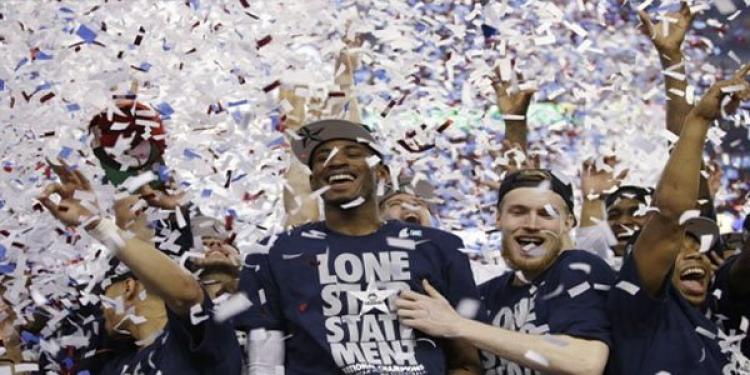Connecticut Stuns the World to Win NCAA Championship
Posted: April 8, 2014
Updated: October 4, 2017

#7 Connecticut won 60-54 over Kentucky to win the NCAA championship; they are the lowest seed to win the title in 29 years.
This year’s March Madness tournament was full of surprises. Duke and Kansas lost early in upset games, making a lot of money for online sportsbooks in the US and Canada which depend on upsets to make money. Upcoming star Andrew Harrison won two games with game-winning shots in the final seconds, and two low-seeded teams made the Final Four for the first time since 2000. Kentucky fell, rose and fell again.
But no story is better than that of the Connecticut Huskies. Two years ago their long-time coach Jim Calhoun was forced to retire due to health problems, and last year the Huskies were banned from postseason play due to academic violations. Calhoun was replaced by the inexperienced Kevin Ollie, and entering the season the Huskies were viewed as a one-trick pony: star guard Shabazz Napier and little else. They proved everyone wrong, and last night completed the Cinderella story by beating Kentucky 60-54 to win the NCAA championship.
In the national semi-final against Florida, not a soul had Connecticut winning. Bookmakers like Bovada and Bet365 gave Florida the highest odds of winning, and the Gators gave no reason to doubt them. Almost everyone engaging in online or mobile betting picked the Gators. The Huskies won on the back of hellacious defense, holding Florida’s star guard Scottie Wilbekin to only four points and winning 63-53.
Three hours later the Huskies had achieved true basketball blue blood status; their four championships in fifteen years are more than any school since the UCLA Bruins destroyed the competition during the 1960s and 1970s. The Huskies beat the Cats 60-54, maintaining a slim lead over their opponent throughout the game. How did they do it?
The same way they succeeded throughout the tournament: they out-toughed opponents and guards Napier and Boatright controlled the pace of the game throughout. Kentucky’s star forward Julius Randle may be a future NBA player, but he was frustrated throughout the game by Connecticut’s less-heralded post-players. And Napier was clearly the best player on the court throughout the game, scoring 22 points and using his bloody-knuckle Boston swagger to dominate Kentucky’s younger and softer Harrison.
Connecticut taught us a few things this year. The first is that experience can’t be undervalued during March Madness. Their team may not be packed full of future NBA stars, but these guys have been around the block and know how to win tough games. Playing basketball can be like navigating and underground high-stakes American poker room. You’ve got to have grit and be able to pounce on your opponent’s weaknesses. The second is that Connecticut’s model of building around tough guards from Northern cities like New York and Boston pays off. This year they built around Napier of Boston, last time it was Brooklyn’s Kemba Walker, and before that it was Taliek Brown of Manhattan. These kids are tough as nails and have a flair for the dramatic.
This year’s March Madness tournament was full of surprises. Duke and Kansas lost early in upset games, making a lot of money for online sportsbooks in the US and Canada which depend on upsets to make money. Upcoming star Andrew Harrison won two games with game-winning shots in the final seconds, and two low-seeded teams made the Final Four for the first time since 2000. Kentucky fell, rose and fell again.
But no story is better than that of the Connecticut Huskies. Two years ago their long-time coach Jim Calhoun was forced to retire due to health problems, and last year the Huskies were banned from postseason play due to academic violations. Calhoun was replaced by the inexperienced Kevin Ollie, and entering the season the Huskies were viewed as a one-trick pony: star guard Shabazz Napier and little else. They proved everyone wrong, and last night completed the Cinderella story by beating Kentucky 60-54 to win the NCAA championship.
Season recap
The Huskies didn’t impress many people during the regular season but they managed to finish third in a weak American Athletic Conference and landed a #7 seed in the NCAA tournament. They did it mostly on the back of Napier, who completed the trifecta of leading the team in points, rebounds and assists (Napier was also a member of the last Connecticut team to win the NCAA championship, in 2011). Other notable players were DeAndre Daniels and Ryan Boatright. While the team’s play was mediocre aside from a huge victory over Florida in November, observers were generally impressed with the performance of second-year coach Kevin Ollie, who was left to pick up the pieces after the unfortunate departure of Jim Calhoun.• #7 seed Connecticut shocked basketball fans everywhere by beating #8 Kentucky in the national championship .Once March Madness began the Huskies really started playing basketball. In the first round they matched up with Saint Joseph’s, a low-seeded team but one with a history of frustrating opponents. The game was tied 70-70 going into overtime, when Napier went on a tear and the Huskies overpowered the Hawks to win 89-81. To emphasize the significance of that game, if Connecticut had scored one fewer point during regulation they would have lost, and I would be writing a completely different article. After winning their first round game they faced a tough matchup with traditional rival and #2 seed Villanova. Winning this game proved that they were here to stay. Next up they faced Iowa State, a tough #3 seed featuring forward Melvin Ejim, undoubtedly one of the best players in the nation. They pulled off a close upset, winning 81-76 to put themselves in the Elite Eight for the first time since they won the national championship in 2011.
• Connecticut won its fourth March Madness title in the past 15 years
• Huskies guard Shabazz Napier won the tournament’s Most Outstanding Player award
Things heat up
As spring deepens and March turns into April, the stakes are raised and the action becomes more intense. Connecticut’s Elite Eight matchup with Michigan State was billed as one of the premier games of the entire tournament. The Spartans were predicted to win (and many such as Barack Obama had them winning the entire tournament), but the Huskies pulled some tricks out of their bag and won 60-54.In the national semi-final against Florida, not a soul had Connecticut winning. Bookmakers like Bovada and Bet365 gave Florida the highest odds of winning, and the Gators gave no reason to doubt them. Almost everyone engaging in online or mobile betting picked the Gators. The Huskies won on the back of hellacious defense, holding Florida’s star guard Scottie Wilbekin to only four points and winning 63-53.
The final countdown
The final game featured the Huskies and the Kentucky Wildcats, two teams not expected to go very far in March Madness. While the Cats were given only a #8 seed they were touted as the more talented team going into this game, featuring the previously mentioned Andrew Harrison, who turned out to be the tournament’s most clutch player. Grantland writer Mark Titus called Kentucky “the most feared team in the Final Four.”Three hours later the Huskies had achieved true basketball blue blood status; their four championships in fifteen years are more than any school since the UCLA Bruins destroyed the competition during the 1960s and 1970s. The Huskies beat the Cats 60-54, maintaining a slim lead over their opponent throughout the game. How did they do it?
The same way they succeeded throughout the tournament: they out-toughed opponents and guards Napier and Boatright controlled the pace of the game throughout. Kentucky’s star forward Julius Randle may be a future NBA player, but he was frustrated throughout the game by Connecticut’s less-heralded post-players. And Napier was clearly the best player on the court throughout the game, scoring 22 points and using his bloody-knuckle Boston swagger to dominate Kentucky’s younger and softer Harrison.
Connecticut taught us a few things this year. The first is that experience can’t be undervalued during March Madness. Their team may not be packed full of future NBA stars, but these guys have been around the block and know how to win tough games. Playing basketball can be like navigating and underground high-stakes American poker room. You’ve got to have grit and be able to pounce on your opponent’s weaknesses. The second is that Connecticut’s model of building around tough guards from Northern cities like New York and Boston pays off. This year they built around Napier of Boston, last time it was Brooklyn’s Kemba Walker, and before that it was Taliek Brown of Manhattan. These kids are tough as nails and have a flair for the dramatic.
Related content
Subscribe
0 Comments












